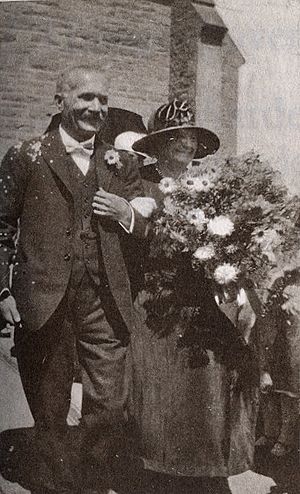Cornelis Jacobus Langenhoven facts for kids
Quick facts for kids
Cornelis Jacobus Langenhoven
|
|
|---|---|

Langenhoven with his wife at the church in Oudtshoorn on the wedding day of their daughter in 1926
|
|
| Born | 13 August 1873 Hoeko, Ladismith, Cape Colony |
| Died | 15 July 1932 (aged 58) Oudtshoorn, South Africa |
| Resting place | Arbeidsgenot, Oudtshoorn |
| Language | Afrikaans |
| Nationality | South African |
| Notable works | "Die Stem van Suid-Afrika", Versamelde Werke (Collected Works) |
| Spouse | Lenie van Velden |
| Children | Engela (b. 1901) |
Cornelis Jacobus Langenhoven (born 13 August 1873 – died 15 July 1932) was a famous South African writer and poet. He used his initials, C.J. Langenhoven, for his published works. He played a very important part in making the Afrikaans language and its literature popular.
His poems helped a lot to promote Afrikaans, which was a new language at the time. He is most famous for writing the words to "Die Stem van Suid-Afrika". This song was the national anthem of South Africa for many years. People often called him Sagmoedige Neelsie (Gentle Neelsie) or Kerneels because he was known for his kind nature.
Contents
Who Was C.J. Langenhoven?
Langenhoven was born in a place called Hoeko, near Ladismith, in what was then the Cape Colony. Later, he moved to Oudtshoorn and became its most well-known resident.
In 1897, he married Lenie van Velden. They had one daughter, Engela, who was born in 1901.
His Work for Afrikaans
In 1914, Langenhoven became a member of parliament. He worked very hard to get Afrikaans officially recognized as a language. He was also one of the people who started the Afrikaans newspaper Die Burger.
His most famous work is the song "Die Stem", which he wrote in 1918. Parts of this song are now included in the current national anthem of South Africa. This new anthem has been used since the 1990s.
To celebrate 100 years since his birth, the South African Post Office released special stamps in 1973.
His Writing Career
Langenhoven wrote many different kinds of stories and poems. He wrote poetry, ghost stories, and even alien stories! He also translated several books into Afrikaans. One of these was the Rubaiyat of Omar Khayyam.
He was a key figure in the movement to make Afrikaans an accepted language. He strongly believed it should be taught as the main language in schools instead of Dutch. His efforts paid off when Afrikaans was officially used in parliament in 1925. By 1927, it was recognized as an official language of South Africa, along with English and Dutch.
What Was He Like?
Langenhoven is seen as one of the most talented writers in Afrikaans. He was very good at writing short stories. People remember him best for his funny and clever works. For example, he even wrote a silly "love poem" for his dog!
He was known for his sharp mind and gentle personality. He also had an imaginary elephant named Herrie (meaning "Harry"). Herrie appeared in many of his stories. In 1929, Langenhoven even carved Herrie's name onto a large rock. This rock is next to the N12 highway near Meiringspoort (outside Oudtshoorn). This special rock, called Herrie's Stone, is now a protected historical site.
His Lasting Impact
- The student center at Stellenbosch University is named after him. Students lovingly call it "Die Neelsie" ("The Neelsie").
- In 1983, a South African filmmaker named Manie van Rensburg made a fun TV series based on Langenhoven's work. It was called Sagmoedige Neelsie.
- A neighborhood in Bloemfontein, called Langenhoven Park, was named in his honor.
- Langenhoven is still considered one of the most productive and versatile Afrikaans writers today. His collected works fill 16 books! People also remember him fondly for his unique personality.
- The house where he and his family lived, called Arbeidsgenot, is now a museum. The name means "the pleasure of work." They lived there from 1901 until 1950.
- Nelson Mandela once shared that in 1964, while in prison, he read a book by Langenhoven. The book was called Shadows of Nazareth and was about the trial of Jesus Christ. Mandela said the book deeply affected him. Langenhoven's writing made it clear that true authority was not with the judge, but with the prisoner.
See also
 In Spanish: Cornelis Jacobus Langenhoven para niños
In Spanish: Cornelis Jacobus Langenhoven para niños

